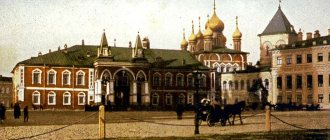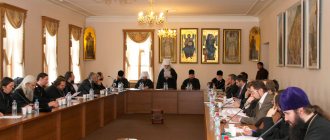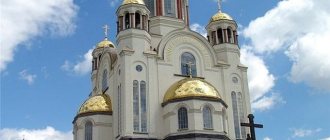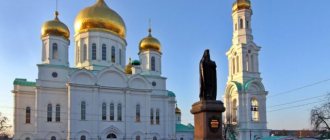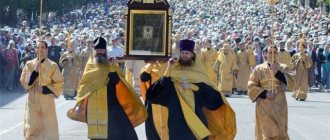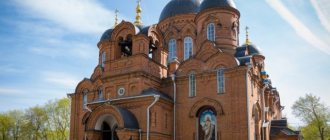| Spaso-Voznesensky Cathedral in Ulyanovsk |
Simbirsk and Novospasskaya diocese
of the Simbirsk Metropolis of the Russian Orthodox Church
- Diocesan administration: Russia, 432017, Ulyanovsk, st. Ulyanovskaya, 2
- Tel/fax (office)
- Official site:
- Canonical territory: Ulyanovsk municipality, Veshkaimsky, Karsunsky, Kuzovatovsky, Mainsky, Novospassky, Sursky, Ulyanovsky, Tsilninsky districts of the Ulyanovsk region
- Cathedral: Spaso-Voznesensky Cathedral in Ulyanovsk
- On the map: Yandex.Map, Google map
The city of Simbirsk (according to the old spelling Sinbirsk, now Ulyanovsk) was founded by the sovereign's decree and boyar sentence of 1648, to protect the lands newly developed by the Russians from Nogai raids.
Already in the first years of the city’s existence, there were 18 churches and chapels that made up the “Simbirsk Tithe” of the Patriarchal Region. In 1657, the Simbirsk tithe was transferred to the jurisdiction of the Metropolitan of Kazan. In connection with the ever-increasing number of churches in the Simbirsk province, the question of establishing an independent Simbirsk diocese was repeatedly raised - in 1784, 1829, and 1830. On February 10, 1832, an independent diocese was formed in the province, separated from the Kazan diocese.
The number of churches and monasteries grew. In 1840, a theological seminary was opened in Simbirsk, then a school for girls of clergy rank in the Simbirsk Spassky Monastery. Under Bishop Theoktiste (1874-1882), deanery councils were established, district and diocesan congresses of the clergy were organized, a missionary committee, the St. Nicholas Anti-Schismatic Brotherhood, and the Brotherhood of the Three Hierarchs at the seminary began to work. At the same time, the Simbirsk Diocesan Gazette began to be published and a women's diocesan school was organized. Under Bishop Nikandra (1895-1904), over 150 church schools were opened in the diocese, the Department of the Imperial Orthodox Palestine Society and the Cyril and Methodius Brotherhood were established at the Simbirsk Men's Theological School.
Due to the growing population of the vast diocese and the need to work on the conversion of Muslims and those who had fallen away from Orthodoxy, the see of the suffragan bishop of Alatyr was established in 1912. In 1914, the Bishop created the Simbirsk Diocesan Church-Archaeological Society, and also began publishing the collection “Simbirsk Church Antiquities.”
The church unrest that began after the February Revolution in 1917 marked the beginning of a difficult period of upheaval of the century and interrupted the development of the diocese. “Progressive” figures appeared among the clergy; believers were promised “democracy” not only on earth, but also in heaven. The last bishop of the Simbirsk diocese of the pre-revolutionary period, Archbishop Veniamin, deviated into the renovationist schism in 1922. In November 1920, the department was headed by Archbishop Alexander, who after some time became the organizer of the “Simbirsk Independent Church” - a movement that did not exist for long, but brought even greater turmoil into local church life.
With the renaming of the cathedral city of Simbirsk in 1924 to Ulyanovsk, the name of the diocese was also changed.
By 1926, Ulyanovsk had two diocesan administrations and two cathedral cathedrals: Renovationist and Orthodox, and the Orthodox Bishop Vissarion (Zornin) switched to the Gregorian schism in the same year. In 1927, he managed to convince the majority of participants in the congress of the diocese to follow him, but the patriarchal diocese was replaced in the same year by Bishop Joachim (Blagovidov). Thus, Ulyanovsk became the center of three dioceses.
In the 1930s, as in other parts of the USSR, there was a destruction of church life by secular authorities, which was especially manifested in the persecution of the clergy and the closure of churches. In 1935-1937, the diocese was administered from the city of Melekess, and then the department was discontinued. More than one bishop and many clergy of the diocese then met violent death or imprisonment.
In November 1941, the Patriarchate, the heads of renovationism and the All-Union Council of Evangelical Christians were evacuated from Moscow to Ulyanovsk. The premises of the former Polish church were given to the Moscow Patriarchate, and the Renovationists were given a temple in the name of the Burning Bush Icon of the Mother of God. In November 1941, the Ulyanovsk diocese was also revived. From 1941 to 1943, the city became the seat of the head of the Russian Orthodox Church, Patriarchal Locum Tenens Metropolitan Sergius (Stragorodsky). In July 1943, before leaving for Moscow, a pre-conciliar meeting was held in the building of the former Elias Church, at which Metropolitan Sergius was recommended for election as Patriarch of Moscow and All Rus'.
Since 1959, the diocese was deprived of its bishop due to another round of anti-church persecution in the USSR. In June-September 1959, it came under the jurisdiction of the Kuibyshev archpastor, then the Saratov archpastor, and then was again entrusted to the Kuibyshev rulers.
The Ulyanovsk diocese was restored on September 13, 1989, its borders coincided with the borders of the Ulyanovsk region. For the first year and a half of his stay in Ulyanovsk, Bishop Proclus lived in a hotel, and the diocesan administration for the first year was located in the basement of the Neopalimovsky Cathedral. In 1993, the Zhadovsky monastery was revived and a new women’s Komarovsky St. Michael the Archangel Monastery was opened. In general, things were going badly between the leadership of the diocese and the local secular authorities, “the preserve of Bolshevism,” and the restoration of the diocese, although it was going on, was mostly contrary to the actions of the secular leaders. This situation persisted towards the end of the 1990s, although promises were made to help the Church during the election campaigns.
Although the cathedral city continued to be called by its former name, in 2001 the historical name was returned to the diocese.
On July 26, 2012, the Barysh and Melekes dioceses were separated from the Simbirsk diocese. All three dioceses were included in the newly formed Simbirsk Metropolis. The title of the ruling bishop of the Simbirsk diocese was changed to “Simbirsk and Novospassky”.
Historical names
- Simbirsk and Syzran (February 10, 1832 - 1923)
- Ulyanovskaya (1924 - 1944)
- Ulyanovskaya and Melekesskaya (1944 - 2001)
- Simbirskaya and Melekesskaya (July 17, 2001 - July 26, 2012)
- Simbirskaya and Novospasskaya (since July 26, 2012)
Statistics
- 1830 - on the territory of the province there are 598 churches, 9 cathedrals, 7 monasteries (3 men's and 2 women's)
- 1832 - there are 603 parish churches and 788 clergy in the diocese
- beginning V. — 9 monasteries (3 men’s and 6 women’s); 829 churches, including 9 cathedrals, 698 parish churches, 68 affiliated churches, 15 cemetery churches, 16 house churches and at various institutions; in male monasteries there are 60 monks, 115 novices; in women's monasteries there are 152 monastics, 882 novices; clergy: archpriests - 45, priests - 744, deacons - 237, psalmists - 680; persons of the Orthodox faith: males - 761,715, females - 790,000; libraries at churches - 674, parish trustees - 309; hospitals at churches - 1, at monasteries - 3
- beginning 1911 - in addition to the Orthodox flock, approx. 500 pagans; up to 175,000 unbaptized Tatars; up to 7.5 thousand baptized Tatars and Chuvash who fell away from Christianity; over 28 thousand non-priest schismatics and 5.5 thousand priests; hundreds of sectarians - Molokans (both Resurrectionists and Subbotniks), Stundo-Baptists, Pashkovites and Tolstoyans [1]
- 1912 - churches - 774, chapels - 192; monasteries - 11 (5 women's); 1 theological seminary, 3 theological schools, 1 diocesan women's school, 471 church schools; libraries at churches - 674; hospitals - 4
- 1914 - approx. 890 parishes
- January 1, 1958 [2] - 19 registered temples/houses of worship
- 1989, upon revival - 9 operating churches, 2 of them in Ulyanovsk
- January 1, 1994 - registered communities 67 (operating churches - 52)
- October 1994 – registered parishes 72
- con. 1999 - 100 parishes were registered, of which 84 were active, 16 were being established [1]
- February 2012 - churches and other places of worship (houses of prayer, rooms, chapels, etc.) - 229; parishes with legal registration - 145, without legal registration - 60; clergy and monastics - 196: priests - 175, deacons - 21, monastics (mantle and cassock): priests - 27, deacons - 4; monastics staying in monasteries (mantle and cassock): male monasticism with ordination - 9, male monasticism without ordination - 11, female monasticism - 18 [3]
Bishops
- Anatoly (Maksimovich) (February 10, 1832 - August 7, 1842)
- Feodoty (Ozerov) (August 7, 1842 - August 20, 1858)
- Evgeny (Sakharov-Platonov) (October 13, 1858 - December 7, 1874)
- Feoktist (Popov) (December 7, 1874 - September 28, 1882)
- Barsanuphius (Okhotin) (September 28, 1882 - August 12, 1895)
- Nikandr (Molchanov) (August 23, 1895 - April 23, 1904)
- Gury (Burtasovsky) (April 23, 1904 - January 5, 1907)
- Jacob (Pyatnitsky) (January 25, 1907 - December 10, 1910)
- Veniamin (Muratovsky) (December 31, 1910 - July 13, 1920)
- Tikhon (Vasilevsky) (January 1919 - September 1920) high school, archbishop. b. Kursk
- Seraphim (Silichev) (June 12, 1924 - March 25, 1925) high school, bishop. Syzransky
- Sschmch. Herman (Kokkel) (1926) v/u, ep. Ibresinsky
- Seraphim (Zborovsky) (November 1, 1932 - 1933) high school bishop. Melekessky
- Seraphim (Zborovsky) (1933 - June 29, 1934) high school bishop. Cheboksary
- Artemon (Evstratov) (1934) v/u, ep. Buguruslansky
- Alexy (Palitsyn) (September 2 - October 17, 1942) v/u, archbishop. Kuibyshevsky
- June - September 1959 - ruled by the Kuibyshev archpastor
- September 12, 1959 - March 22, 1960 - ruled by the Saratov archpastor
- 1960 - 1989 - ruled by Kuibyshev archpastors
- Zinovy (Korzinkin) (March 24 - May 30, 2014) supreme, Metropolitan. Saransk
Russian Orthodox Church
Part of the Simbirsk Metropolis
Founded on February 10, 1832 (old style). In 1934-1935 there was no bishopric in the diocese, and the city of Melekess, from where the leadership of the diocese was exercised, belonged to the Ufa diocese. On October 22, 1935, the department was restored.
In 1959-1988. was temporarily governed by the bishops of the Kuibyshev diocese. On September 14, 1989, by decree of His Holiness Patriarch Pimen and the Holy Synod, an independent diocese was revived.
By the decision of the Holy Synod of July 26, 2012 (magazine No. 61), the Barysh and Melekes dioceses were separated from the diocese. The Simbirsk diocese is included in the Simbirsk Metropolis. The Synod decided to have the title “Simbirsk and Novospassky” for the ruling bishop.
Diocese today (as of February 2021)
Deaneries and deaneries
- I Simbirskoye City (Leninsky and Zavolzhsky districts of Ulyanovsk) - Archpriest Nikolai Kosykh
- II Simbirskoye City (Zasviyazhsky and Zheleznodorozhny districts of Ulyanovsk) - Archpriest Roman Karpov
- Novoulyanovskoe (Novoulyanovsk, Ulyanovsk district, Ulyanovsk region) - Priest Nikolai Gensitsky
- Tsilninskoe (Tsilninsky district of the Ulyanovsk region) - priest Vladimir Manyakov
- Veshkaimskoye (Veshkaimsky and Mainsky districts of the Ulyanovsk region) - Archpriest Anatoly Kapranov
- Karsunskoye (Karsunsky and Sursky districts of the Ulyanovsk region) - Archpriest Gennady Bobrov
- Novospasskoye (Novospassky and Kuzovatovsky districts of the Ulyanovsk region) - Hieromonk Peter (Ivanov)
Monasteries and monastery farmsteads
- Mikhailo-Arkhangelsk female 433725, Ulyanovsk region, Ulyanovsk district, village. Komarovka, st. Monastyrskaya, 26; tel., fax (8425) 46-12-60; e-mail; website https://komarovka.ortox.ru abbess - abbess Magdalene (Metropolitan)
- Vladimir Compound 432046, Ulyanovsk, st. Volzhskaya, 52; e-mail abbess - Abbess Magdalene (Metropolitan); elder sister - nun Zosima (Netsvetaeva
The total number of churches and other places of worship (houses of prayer, rooms, chapels, etc.) is 154. Parishes are 119.
The number of full-time
clergy is 131, including:
- priests - 116;
- deacons - 15.
Of these, monastics (mantle and ryassophore), including:
- priests - 17;
- deacons - 1.
Monastics staying in monasteries (mantle and ryassophore):
- female monasticism - 33.
Social institutions
- Spiritual and Patriotic Center 432047, Ulyanovsk, p. Arskoye, temple complex in honor of the Epiphany; e-mail director - Archpriest Alexy Kormishin
- Pre-abortion counseling center at the antenatal clinic, Ulyanovsk, st. Dostoevsky, 22; tel. +7 917 604-23-89 leader - Priest Dimitry Subbotin; performer - senior sister of mercy Anastasia Nikiforova
- Rehabilitation program for alcohol and drug addicts on the basis of the regional drug treatment clinic, Ulyanovsk, st. Polbina, 36; tel. leader - Archpriest Sergiy Gordopolov
- Community of Sisters of Charity in honor of St. Elizabeth. (Care for seriously ill patients in the Gerontological Center) Ulyanovsk, st. Orenburgskaya, 31; tel. (Kuzmina Galina Anatolyevna)
- Community of Sisters of Mercy in honor of the miracle worker Andrei Simbirsky, Ulyanovsk, st. Polbina 45A, St. right Philaret the Merciful at the Integrated Center for Social Services for the Population “Istok”, senior sister of mercy - Anastasia Nikiforova (tel. +7 917 604-23-89)
- Humanitarian aid warehouse “Blagostynya” at the Church of the Annunciation of the Blessed Virgin Mary, Ulyanovsk, st. Sholmova, 18; VKontakte page https://vk.com/gymsklad_ul73 manager - Anastasia Nikiforova (tel. +7 917 604-23-89)
Diocesan media
- newspaper “Orthodox Simbirsk” (the official printed organ of the Simbirsk Metropolis, published twice a month) legal address: 432071, Ulyanovsk, lane. Outpatient, 8; actual: 432017, Ulyanovsk, st. Ulyanovskaya, 2; for letters: 432000, Ulyanovsk, st. Goncharova 8/62, Main Post Office, PO Box 121; tel.; e-mail editor-in-chief — Ksenia Manyakova
- official website of the diocese https://www.mitropolia-simbirsk.ru/432017, Ulyanovsk, st. Ulyanovskaya, 2; e-mail
Educational establishments
- Diocesan Department of Religious Education and Catechesis 432071, Ulyanovsk, lane. Ambulatory, 8, room. 8; tel.: (8422) 44-94-06; Fax; e-mail; website https://eoroik.rf/
- diocesan educational courses 432071, Ulyanovsk, lane. Outpatient, 8; tel.: (8422) 44-94-06; Fax; e-mail [email protected] leader and confessor - Priest Vladimir Manyakov
“Saratov is crying.” The Simbirsk diocese was headed by Metropolitan Longin, Bishop Joseph goes to Buryatia
On August 25, the Holy Synod decided to appoint Metropolitan Longin of Saratov and Volsk as head of the Simbirsk diocese. Metropolitan Joseph of Simbirsk and Novospassky is transferred to the see in Buryatia.
The new metropolitan is 59 years old, born in Sukhumi into a family of employees. He graduated from the evening department of the Faculty of Philology of the Abkhaz State University. He worked as a tour guide and taught Russian language and literature at a high school. He served in the army, and after demobilization he entered the Moscow Theological Seminary. After graduation, he was sent to study at the Sofia Theological Academy. During his studies in Bulgaria, he served as a priest in the Russian Church of St. Nicholas in Sofia. In 1992, after completing his studies, he returned to the Trinity-Sergius Lavra and served as an assistant housekeeper. In 1992, he was appointed rector of the Moscow metochion of the Trinity-Sergius Lavra. In 2003 he was ordained Bishop of Saratov and Volsky, and in 2011 he was appointed head of the newly formed Saratov Metropolis. On October 8, 2011, he was elevated to the rank of metropolitan. He is the rector of the Saratov Orthodox Theological Seminary, a higher religious educational institution; Chairman of the editorial board of the magazine “Orthodoxy and Modernity”, member of the editorial board of the magazine “Alpha and Omega”.
“I have been transferred to another department. It is difficult for me to express in words the feelings that I am experiencing right now. Over these years, I have become close to the city, the diocese and, most importantly, the people with whom the Lord united me,” writes Metropolitan Longin on his Facebook page. “I am immensely grateful to God for everyone who helped me carry out my obedience these years and created church life with me on Saratov land. It pains me very much to part with you, my dears, but you will forever remain in my heart. May the Lord bless the Saratov land and everyone living on it with peace, prosperity and prosperity. From the bottom of my heart I apologize to everyone who I have offended in any way. Let joint prayer continue to unite us, despite the distances.”
Separately, we highlight several comments under Longin’s post about the transfer to the Ulyanovsk region:
Anna Danilova, pravmir.ru publication: “The era of Bishop Metropolitan Longin in Saratov has ended. Saratov is crying. How much has been done, how many churches have been restored... We recently talked about this with the Bishop. Very sad. Very.”
Anton Glozman: “I lived in Saratov until the 11th grade, my mother worked all her life in the Saratov Museum of Local History. I confirm, Saratov is crying. Vladyka Longin was really able to win over many people to the Church - the local museum community, the intelligentsia (despite the fact that relations before him were, to put it mildly, very strained). It’s a terrible pity for Saratov.”
Denis Svechnikov: “It’s a pity. I studied at the Saratov Seminary in absentia, everyone had very good reviews of Bishop Longin, and he himself gave the impression of a very worthy archpastor. I hope that in his new place he will be able to bring as much benefit as in Saratov.”
Metropolitan Joseph headed the Simbirsk diocese for only a year: in August 2019, he replaced Bishop Anastasy. During this time, several scandals arose around the local Russian Orthodox Church: the case of the exchange of the pavilion, for which the former vice-mayor of Ulyanovsk Mikhail Sychev is now in pre-trial detention; Joseph also suspended the Ulyanovsk archpriest from service for three years for membership in United Russia. Joseph’s right hand, the rector of the Annunciation Church, Hieromonk Tikhon, was accused of raising prices and dismissing employees. Also discussed was the ban on holding funeral services at home, only in the church at the Isheevskoye cemetery. Under Joseph, the site for the construction of a new cathedral of the Spassky Monastery in the center of Ulyanovsk was consecrated.
History of the creation of the metropolis
In 1988, Bishop Proclus, who took over the leadership of the Ulyanovsk diocese, noted the complete absence of temples and churches in the city of Lenin, Ulyanovsk. Over 10 years of difficult work, the diocese numbered 100 parishes, Ulyanovsk was enriched with nine churches, which at that time were under construction or restoration.
On July 17, 2001, under the leadership of the Bishop of Simbirsk and Melekess, a diocese was founded, in which new Orthodox churches and monasteries were opened every year.
Spaso-Voznesensky Cathedral in Ulyanovsk
Archbishop Proclus personally supervised the ongoing construction, through his efforts miraculous images and shrines were returned, new martyrs were canonized, Christian schools, seminaries, and universities were opened.
2012 is the time of the founding of the metropolis; on August 1, Archbishop Proclus was ordained to the rank of metropolitan.
Since 2021, the head of the metropolis is Metropolitan Joseph (Balabanov), who replaced Metropolitan Anastasy (Metkin).
Metropolitan dioceses
The Barysh diocese, whose center is located in Barysh, is headed by Archimandrite Filaret (Konkov), rector of the Mother of God of Kazan Zhadov Monastery. The boundaries of the Barysh diocese extend to the following areas:
- Baryshsky;
- Inzensky;
- Nikolaevsky;
- Bazarnosyzgansky;
- Pavlovsky;
- Starokulatkinsky;
- Radishchevsky.
The center of the Melekess diocese, formed in the same year as the metropolis, is located in Dimitrovgrad, headed by the Bishop of Melekess and Cherdara Isaev Dmitry. The Melekess diocese includes the following parishes:
- Melekessky;
- Novomalyklinsky;
- Sengileevsky;
- Staromainsky;
- Terengulsky;
- Cherdaklinsky and the city of Dimitrovgrad.
Metropolitan Joseph of Simbirsk and Novospassky
The Simbirsk diocese was founded in 1862, later it was temporarily part of the Ufa and Kuibyshev diocese, and since 1989 it has been an independent diocese, headed by Metropolitan Anastasius (Metkin) of Simbirsk and Novospassky.
After the formation of the metropolis, the following parishes remained in the Simbirsk diocese:
- Simbirsk;
- Novoulyanovsky;
- Veshkaimsky;
- Karsunsky;
- Novospassky.
